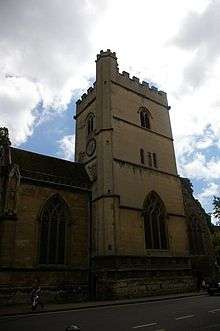St Mary Magdalen's Church, Oxford
| St Mary Magdalen | |
|---|---|
 | |
| 51°45′17″N 1°15′32″W / 51.754620°N 1.258826°WCoordinates: 51°45′17″N 1°15′32″W / 51.754620°N 1.258826°W | |
| Location | Magdalen Street, Oxford |
| Country | England |
| Denomination | Church of England |
| Churchmanship | Anglo-Catholic |
| Website | St Mary Magdalen, Oxford |
| History | |
| Dedication | Mary Magdalene |
| Administration | |
| Deanery | Oxford |
| Archdeaconry | Oxford |
| Diocese | Oxford |
| Province | Canterbury |
St Mary Magdalen is a Church of England parish church in Magdalen Street, Oxford, England. The church is just to the north of the former city wall.
History
A Saxon wooden church stood at the present site a thousand years ago, but was burnt down in 1074.[1] Robert D'Oyly, the Norman Constable of Oxford, then built a single aisle chapel to replace the wooden church. Subsequently, Saint Hugh, the Bishop of Lincoln, rebuilt the church in 1194. His work can still be seen at the east chancel wall and the south aisle, as well as the altar dedicated to St Thomas Becket. A century later the scholars of newly founded Balliol College had an oratory dedicated to St Catherine in the present north aisle; and in 1320 the Carmelites founded a chapel in the south aisle, preserved as a unified piece to form the present Lady Chapel. Work on the tower began in 1513 and continued during the upheavals of the Reformation; some of the stones of Rewley Abbey, Oxford's Cistercian monastery, strengthened the base of the tower. In 1841–42, George Gilbert Scott, then young and unknown, rebuilt the chancel and the north aisle. This complemented his Martyrs' Memorial just north of the church. It was the first Victorian Gothic interior in Oxford.
Worship
Worship at St Mary Magdalen's is in the high, Anglo-Catholic tradition.[2] Mass is celebrated 15 times per week: twice daily on weekdays, and three times on Sundays. The principal celebration is at 10:30 am on Sunday mornings.
The bells in the church have been rung regularly by the Oxford University Society of Change Ringers since the 1930s. They were augmented to be a ring of 10 bells in 2002.[3]
See also
- Oxford University Society of Change Ringers
- St Michael at the Northgate, to the south
- St Giles' Church, to the north
References
Further reading
- Sherwood, Jennifer; Pevsner, Nikolaus (1974). Oxfordshire. The Buildings of England. Harmondsworth: Penguin. pp. 293–294. ISBN 0-14-071045-0.